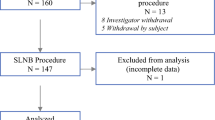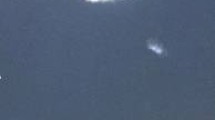Abstract
Background
Sentinel lymph node (SLN) mapping with radioisotope and blue dye is rapidly becoming the standard of care for breast cancer. The optimal location for injection of radioisotope and blue dye is still being investigated. The goal of this study was to determine whether blue dye injection into the subareolar (SA) location localized the same sentinel nodes as the peritumoral (PT) location for patients with breast cancer.
Methods
Three hundred thirty-two patients with biopsy-proven operable breast cancer or ductal carcinoma in situ at two institutions underwent SLN mapping. Eighty-three patients had PT injection of blue dye (group 1), and 249 patients had SA injection of blue dye (group 2). All patients underwent PT injection of99mTc-labeled sulfur colloid.
Results
The two groups were similar in age, previous biopsy type, and tumor size, location, and histology. The mean number of SLNs identified was 2.4 (range, 0–9) in group 1 and 2.5 (range, 0–11) in group 2. The SLN identification rate was 95% for group 1 and 97% for group 2. The isotope success rate was 94% for both groups. The blue dye success rate was 84% for group 1 and 90% for group 2. The isotope/blue dye concordance rate was 87% for group 1 and 90% for group 2. At a median follow-up of 28 months (range, 14 to 40), there were no axillary recurrences in any of the 332 patients.
Conclusions
These data suggest that delivery of mapping reagents in the SA and PT locations identifies similar lymph nodes. Because of simplicity and the similarity in node identification between SA and PT injection, further investigation of the SA site for delivery of SLN mapping reagents for breast cancer is warranted.
Similar content being viewed by others
References
Fisher B, Wolmark N, Bauer M, Redmond C, Gebhardt M. The accuracy of clinical nodal staging and of limited axillary dissection as a determinant of histologic nodal status in carcinoma of the breast.Surg Gynecol Obstet 1981;152:765–72.
Consensus conference. Adjuvant chemotherapy for breast cancer.JAMA 1985;254:3461–3.
NIH consensus conference. Treatment of early-stage breast cancer.JAMA 1991;265:391–5.
Ivens D, Hoe AL, Podd TJ, Hamilton CR, Taylor I, Royle GT. Assessment of morbidity from complete axillary dissection.Br J Cancer 1992;66:136–8.
Kissin MW, Querci della Rovere G, Easton E, Westbury G. Risk of lymphoedema following the treatment of breast cancer.Br J Surg 1986;73:580–4.
Larson D, Weinstein M, Goldberg I, et al. Edema of the arm as a function of the extent of axillary surgery in patients with stage I–II carcinoma of the breast treated with primary radiotherapy.Int J Radiat Oncol Biol Phys 1986;12:1575–82.
Keramopoulos A, Tsionou C, Minaretzis D, Michalas S, Aravantinos D. Arm morbidity following treatment of breast cancer with total axillary dissection: a multivariated approach.Oncology 1993; 50:445–9.
Cabanes PA, Salmon RJ, Vilcoq JR, et al. Value of axillary dissection in addition to lumpectomy and radiotherapy in early breast cancer. The Breast Carcinoma Collaborative Group of the Institut Curie.Lancet 1992;339:1245–8.
Gould EA, Winship T, Philbin PH, Kerr HH. Observations on a “sentinel node” in cancer of the parotid.Cancer 1960;13:77–8.
Cabanas RM. An approach for the treatment of penile carcinoma.Cancer 1977;39:456–66.
Morton DL, Wen DR, Wong JH, et al. Technical details of intraoperative lymphatic mapping for early stage melanoma.Arch Surg 1992;127:392–9.
Krag DN, Weaver DL, Alex JC, Fairbank JT. Surgical resection and radiolocalization of the sentinel lymph node in breast cancer using a gamma probe.Surg Oncol 1993;2:335–9.
Giuliano AE, Kirgan DM, Guenther JM, Morton DL. Lymphatic mapping and sentinel lymphadenectomy for breast cancer.Ann Surg 1994;220:391–8.
Albertini JJ, Lyman GH, Cox C, et al. Lymphatic mapping and sentinel node biopsy in the patient with breast cancer.JAMA 1996;276:1818–22.
Pijpers R, Meijer S, Hoekstra OS, et al. Impact of lymphoscintigraphy on sentinel node identification with technetium-99m-colloidal albumin in breast cancer.J Nucl Med 1997;38:366–8.
Guenther JM, Krishnamoorthy M, Tan LR. Sentinel lymphadenectomy for breast cancer in a community managed care setting.Cancer J Sci Am 1997;3:336–40.
Borgstein PJ, Pijpers R, Comans EF, Van Diest PJ, Boom RP, Meijer S. Sentinel lymph node biopsy in breast cancer: guidelines and pitfalls of lymphoscintigraphy and gamma probe detection.J Am Coll Surg 1998;186:275–83.
Barnwell JM, Arredondo MA, Kollmorgen D, et al. Sentinel node biopsy in breast cancer.Ann Surg Oncol 1998;5:126–30.
O’Hea BJ, Hill AD, El-Shirbiny AM, et al. Sentinel lymph node biopsy in breast cancer: initial experience at Memorial Sloan-Kettering Cancer Center.J Am Coll Surg 1998;186:423–7.
Bass SS, Cox CE, Ku NN, Berman C, Reintgen DS. The role of sentinel lymph node biopsy in breast cancer.J Am Coll Surg 1999;189:183–94.
McMasters KM, Wong SL, Martin RC, et al. Dermal injection of radioactive colloid is superior to peritumoral injection for breast cancer sentinel lymph node biopsy: results of a multiinstitutional study.Ann Surg 2001;233:676–87.
Veronesi U, Paganelli G, Galimberti V, et al. Sentinel-node biopsy to avoid axillary dissection in breast cancer with clinically negative lymph-nodes.Lancet 1997;349:1864–7.
Linehan DC, Hill AD, Akhurst T, et al. Intradermal radiocolloid and intraparenchymal blue dye injection optimize sentinel node identification in breast cancer patients.Ann Surg Oncol 1999;6:450–4.
Boolbol SK, Fey JV, Borgen PI, et al. Intradermal isotope injection: a highly accurate method of lymphatic mapping in breast carcinoma.Ann Surg Oncol 2001;8:20–4.
Borgstein PJ, Meijer S, Pijpers R. Intradermal blue dye to identify sentinel lymph-node in breast cancer.Lancet 1997;349:1668–9.
Kern KA. Sentinel lymph node mapping in breast cancer using subareolar injection of blue dye.J Am Coll Surg 1999;189:539–45.
Mertz L, Mathelin C, Marin C, et al. [Subareolar injection of 99m-Tc sulfur colloid for sentinel node identification in multifocal invasive breast cancer].Bull Cancer 1999;86:939–45.
Klimberg VS, Rubio IT, Henry R, Cowan C, Colvert M, Korourian S. Subareolar versus peritumoral injection for location of the sentinel lymph node.Ann Surg 1999;229:860–4.
Borgstein PJ, Meijer S, Pijpers RJ, Van Diest PJ. Functional lymphatic anatomy for sentinel node biopsy in breast cancer: echoes from the past and the periareolar blue method.Ann Surg 2000;232:81–9.
Kern KA, Rosenberg RJ. Preoperative lymphoscintigraphy during lymphatic mapping for breast cancer: improved sentinel node imaging using subareolar injection of technetium 99m sulfur colloid.J Am Coll Surg 2000;191:479–89.
Flett MM, Going JJ, Stanton PD, Cooke TG. Sentinel node localization in patients with breast cancer.Br J Surg 1998;85:991–3.
Krag D, Weaver D, Ashikaga T, et al. The sentinel node in breast cancer—a multicenter validation study.N Engl J Med 1998;339:941–6.
Roumen RM, Valkenburg JG, Geuskens LM. Lymphoscintigraphy and feasibility of sentinel node biopsy in 83 patients with primary breast cancer.Eur J Surg Oncol 1997;23:495–502.
Miner TJ, Shriver CD, Jaques DP, Maniscalco-Theberge ME, Krag DN. Ultrasonographically guided injection improves localization of the radiolabeled sentinel lymph node in breast cancer.Ann Surg Oncol 1998;5:315–21.
Cox CE, Pendas S, Cox JM, et al. Guidelines for sentinel node biopsy and lymphatic mapping of patients with breast cancer.Ann Surg 1998;227:645–51.
Hill AD, Tran KN, Akhurst T, et al. Lessons learned from 500 cases of lymphatic mapping for breast cancer.Ann Surg 1999;229:528–35.
Bedrosian I, Reynolds C, Mick R, et al. Accuracy of sentinel lymph node biopsy in patients with large primary breast tumors.Cancer 2000;88:2540–5.
Nwariaku FE, Euhus DM, Beitsch PD, et al. Sentinel lymph node biopsy, an alternative to elective axillary dissection for breast cancer.Am J Surg 1998;176:529–31.
Veronesi U, Paganelli G, Viale G, et al. Sentinel lymph node biopsy and axillary dissection in breast cancer: results in a large serie.J Natl Cancer Inst 1999;91:368–73.
Beller F. Development and anatomy of the breast. In: Mitchell G, Bassett L, eds.The Female Breast and Its Disorders. Baltimore: Williams & Wilkins 1990:1–2.
Spratt J, Tobin G. Gross anatomy of the breast. In: Donegan W, Spratt J, eds.Cancer of the Breast, Philadelphia: WB Saunders, 1995:37–42.
Gray J. The relation of the lymphatic vessels to the spread of cancer.Br J Cancer 1939;26:462–95.
Sappey MPC.Injection Preparation et Conservation des Vais-Seaux Lyphatics (thes pour le doctorat en medecine, No. 241). Paris: Rignoux Imprimeur de la Faculte de Medecine, 1834.
Rouviere H.Anatomy of the Human Lymphatic System: A Compendium. Ann Arbor, MI: Edwards Brothers, 1938.
Grant RN, Tabah EJ, Adair FE. The surgical significance of the subareolar lymph plexus in cancer of the breast.Surgery 1953;33:71–8.
Turner-Warwick RT. The lymphatics of the breast.Br J Surg 1959;46:574–82.
Czerniecki BJ, Scheff AM, Callans LS, et al. Immunohistochemistry with pancytokeratins improves the sensitivity of sentinel lymph node biopsy in patients with breast carcinoma.Cancer 1999;85:1098–103.
Bedrosian I, Scheff AM, Mick R, et al. 99mTc-human serum albumin: an effective radiotracer for identifying sentinel lymph nodes in melanoma.J Nucl Med 1999;40:1143–8.
Gulec SA, Moffat FL, Carroll RG, et al. Sentinel lymph node localization in early breast cancer.J Nucl Med 1998;39:1388–93.
Faries MB, Bedrosian I, Reynolds C, Nguyen HQ, Alavi A, Czerniecki BJ. Active macromolecule uptake by lymph node antigenpresenting cells: a novel mechanism in determining sentinel lymph node status.Ann Surg Oncol 2000;7:98–105.
Czerniecki BJ, Bedrosian I, Faries MB, Alavi A. Revolutionary impact of lymphoscintigraphy and intraoperative sentinel node mapping in the clinical practice of oncology.Semin Nucl Med 2001;31:158–64.
Author information
Authors and Affiliations
Corresponding author
Rights and permissions
About this article
Cite this article
Bauer, T.W., Spitz, F.R., Callans, L.S. et al. Subareolar and peritumoral injection identify similar sentinel nodes for breast cancer. Annals of Surgical Oncology 9, 169–176 (2002). https://doi.org/10.1007/BF02557370
Received:
Accepted:
Issue Date:
DOI: https://doi.org/10.1007/BF02557370




